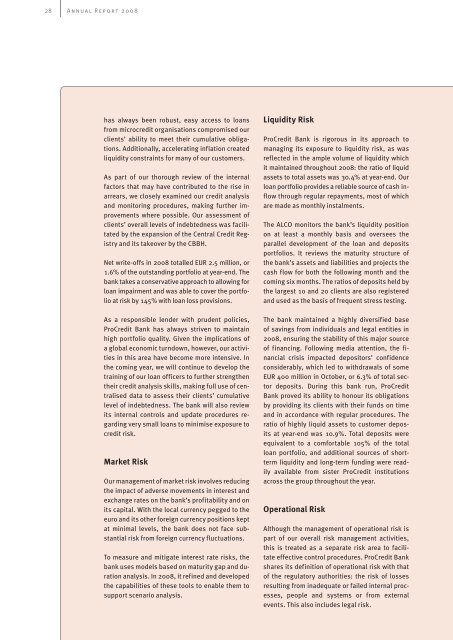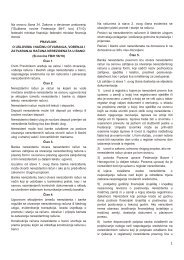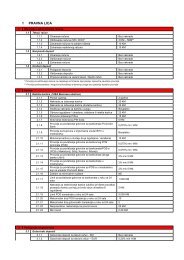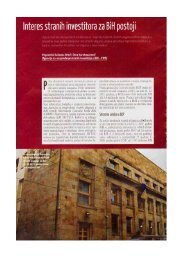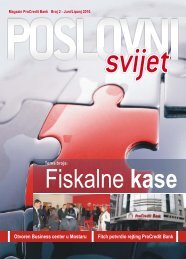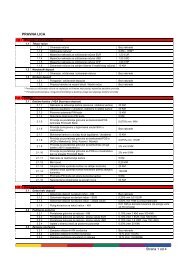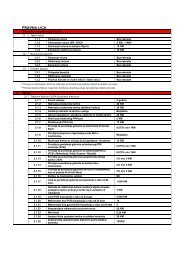Annual Report 2008 - ProCredit Bank
Annual Report 2008 - ProCredit Bank
Annual Report 2008 - ProCredit Bank
You also want an ePaper? Increase the reach of your titles
YUMPU automatically turns print PDFs into web optimized ePapers that Google loves.
28<br />
<strong>Annual</strong> <strong>Report</strong> <strong>2008</strong><br />
has always been robust, easy access to loans<br />
from microcredit organisations compromised our<br />
clients’ ability to meet their cumulative obligations.<br />
Additionally, accelerating inflation created<br />
liquidity constraints for many of our customers.<br />
As part of our thorough review of the internal<br />
factors that may have contributed to the rise in<br />
arrears, we closely examined our credit analysis<br />
and monitoring procedures, making further improvements<br />
where possible. Our assessment of<br />
clients’ overall levels of indebtedness was facilitated<br />
by the expansion of the Central Credit Registry<br />
and its takeover by the CBBH.<br />
Net write-offs in <strong>2008</strong> totalled EUR 2.5 million, or<br />
1.6% of the outstanding portfolio at year-end. The<br />
bank takes a conservative approach to allowing for<br />
loan impairment and was able to cover the portfolio<br />
at risk by 145% with loan loss provisions.<br />
As a responsible lender with prudent policies,<br />
<strong>ProCredit</strong> <strong>Bank</strong> has always striven to maintain<br />
high portfolio quality. Given the implications of<br />
a global economic turndown, however, our activities<br />
in this area have become more intensive. In<br />
the coming year, we will continue to develop the<br />
training of our loan officers to further strengthen<br />
their credit analysis skills, making full use of centralised<br />
data to assess their clients’ cumulative<br />
level of indebtedness. The bank will also review<br />
its internal controls and update procedures regarding<br />
very small loans to minimise exposure to<br />
credit risk.<br />
Market Risk<br />
Our management of market risk involves reducing<br />
the impact of adverse movements in interest and<br />
exchange rates on the bank’s profitability and on<br />
its capital. With the local currency pegged to the<br />
euro and its other foreign currency positions kept<br />
at minimal levels, the bank does not face substantial<br />
risk from foreign currency fluctuations.<br />
To measure and mitigate interest rate risks, the<br />
bank uses models based on maturity gap and duration<br />
analysis. In <strong>2008</strong>, it refined and developed<br />
the capabilities of these tools to enable them to<br />
support scenario analysis.<br />
Liquidity Risk<br />
<strong>ProCredit</strong> <strong>Bank</strong> is rigorous in its approach to<br />
managing its exposure to liquidity risk, as was<br />
reflected in the ample volume of liquidity which<br />
it maintained throughout <strong>2008</strong>: the ratio of liquid<br />
assets to total assets was 30.4% at year-end. Our<br />
loan portfolio provides a reliable source of cash inflow<br />
through regular repayments, most of which<br />
are made as monthly instalments.<br />
The ALCO monitors the bank’s liquidity position<br />
on at least a monthly basis and oversees the<br />
parallel development of the loan and deposits<br />
portfolios. It reviews the maturity structure of<br />
the bank’s assets and liabilities and projects the<br />
cash flow for both the following month and the<br />
coming six months. The ratios of deposits held by<br />
the largest 10 and 20 clients are also registered<br />
and used as the basis of frequent stress testing.<br />
The bank maintained a highly diversified base<br />
of savings from individuals and legal entities in<br />
<strong>2008</strong>, ensuring the stability of this major source<br />
of financing. Following media attention, the financial<br />
crisis impacted depositors’ confidence<br />
considerably, which led to withdrawals of some<br />
EUR 400 million in October, or 6.3% of total sector<br />
deposits. During this bank run, <strong>ProCredit</strong><br />
<strong>Bank</strong> proved its ability to honour its obligations<br />
by providing its clients with their funds on time<br />
and in accordance with regular procedures. The<br />
ratio of highly liquid assets to customer deposits<br />
at year-end was 10.9%. Total deposits were<br />
equivalent to a comfortable 105% of the total<br />
loan portfolio, and additional sources of shortterm<br />
liquidity and long-term funding were readily<br />
available from sister <strong>ProCredit</strong> institutions<br />
across the group throughout the year.<br />
Operational Risk<br />
Although the management of operational risk is<br />
part of our overall risk management activities,<br />
this is treated as a separate risk area to facilitate<br />
effective control procedures. <strong>ProCredit</strong> <strong>Bank</strong><br />
shares its definition of operational risk with that<br />
of the regulatory authorities: the risk of losses<br />
resulting from inadequate or failed internal processes,<br />
people and systems or from external<br />
events. This also includes legal risk.


